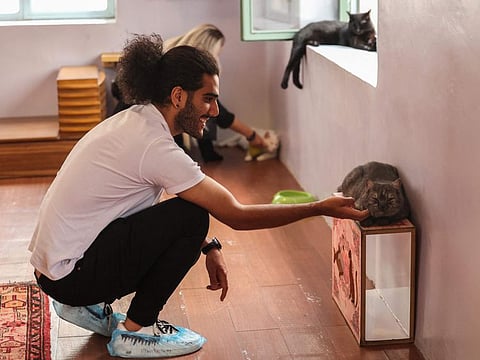Cats are the stars at Tehran ‘meowseum’
Visitors interact and play with adopted cats, which hail from a wide variety of breeds

Tehran: Sprawled nonchalantly across the doorstep, a large tomcat welcomes visitors to Tehran’s cat museum and cafe, a curious establishment where some 30 friendly felines roam freely throughout the exhibition space.
Shahrzad, Farrokh, Shapoor and Shirin are among the real stars of this attraction in a small two-storey building in the centre of the Iranian capital.
Director Hossein HamlehDari says that when it first opened in 2020 it was named the “meowseum”.
It is a place where visitors and cats coexist peacefully in the exhibition rooms and on the cafe terrace.
The privately funded museum’s faded walls feature reproductions of paintings, photos, caricatures and even stamps celebrating the cat from countries as diverse as Iran, South Korea, Guinea and Ukraine.
Most visitors come here seeking to interact and play with the adopted cats, which hail from a wide variety of breeds.
Among them are several Persians, known for their long hair and placid character, a breed which originated in Iran and neighbouring Turkey.
“I love cats, so I really like this place and its friendly atmosphere,” says Mina, a 21-year-old student cuddling a soft brown-coated tomcat.
Her friend Mohammad, 20, says he too is fond of animals as pets, and has decided “to buy a cat” in the coming weeks.
“When people come here and meet Farrokh, a cat that was born blind but is still very agile, they realise cats are also citizens of this city and can coexist with residents,” HamlehDari says.
The animals’ reputation in Iran has suffered knocks in the past because of the large number of strays in big cities, Tehran in particular.
But unlike dogs, cats have been valued pets in Iran for centuries.
“They are represented in many works of art, in particular Persian miniatures,” HamlehDari says.
He cites the example of Babri (“tigerish”) Khan, the famous pet cat of Naser Al Din Shah of the Qajar dynasty, who reigned over the country from 1848 to 1896.
And all Iranians are familiar with the fable “Masnavi of Mush-O Gorbeh” (“The Mouse and the Cat”), a political satire by the 14th century poet Obeid Zakani.
It has become fashionable among wealthy Iranians in recent times to own a dog, preferably a small pedigree breed.
But this trend is not entirely welcomed by religious conservatives and some officials who point out that in Islam dogs are considered impure.
Sign up for the Daily Briefing
Get the latest news and updates straight to your inbox



